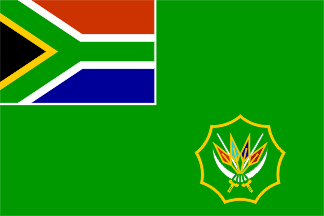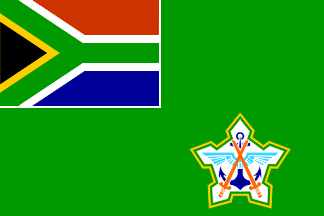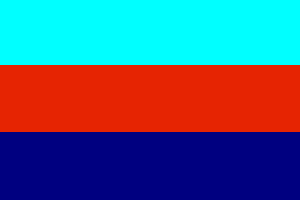sandf.gif) image by Martin Grieve,
10 Nov 2005
image by Martin Grieve,
10 Nov 2005

Last modified: 2006-12-16 by bruce berry
Keywords: national defence force |
Links: FOTW homepage |
search |
disclaimer and copyright |
write us |
mirrors
 image
by Martin Grieve, 10 Feb 2003
image
by Martin Grieve, 10 Feb 2003
"IMPLEMENTATION OF NEW SANDF FLAGS, EMBLEM AND MEDAL SERIES
Another milestone in the transformation process will be the implementation
of the new SANDF flags, depicting the new SANDF emblem. A complete new
medal series is also to be introduced.
On Friday, 25 April 2003, the old SANDF emblem is to be phased out in a Retreat Ceremony. The old SANDF flag will be lowered at the SAAF Gymnasium Parade ground at 18h00, during which the respective Chiefs of the Services will hand back the old SANDF flags to the Chief of the SANDF, General Siphiwe Nyanda.
A colourful parade will take place on Tuesday 29 April 2003, constituting a very visible identity change for the SANDF. During this parade, General Nyanda will present the new SANDF flags and emblem to the senior echelon of the SANDF, as well as the representative groupings of members of all Services and Divisions. On this day the new medal series will also be presented to General Nyanda. This glorious event will start at 09h00 and is to take place at the Air Force Gymnasium.
The new SANDF emblem will incorporate the nine-pointed "Star" representing the warm sun of Africa and the nine provinces. The Star is also used in divisional emblems and flags to reflect a common corporate identity coupled to a divisional-unique devise to still enable a Division to demonstrate uniqueness. The four Services are represented in their respective traditional colours. The emblem also reinforces the idea of military identity, authority and dignity.
The use of the green and gold are the traditional colours used to reflect
the corporate identity of the Department of Defence. Green can also be
seen as referring to the natural wealth of Africa while gold can be seen
as a reference to the mineral wealth as well as nobility and purity.
Jan Oskar Engene, 2 May 2003
At a Retreat ceremony held on Friday 25 April 2003, the old South Africa National Defence Force (SANDF) emblem, based on the Cape Castle outline,
was formally phased out. The old SANDF flag was lowered at the South African Air Force Gymnasium Parade Ground at 18h00. The new SANDF
emblem and flags were presented at a parade presided over by the Chief of the South African National Defence Force, General Siphiwe Nyanda, on
29 April 2003 at Defence Force Headquarters at Thaba Tshwane (formerly
Voortrekkerhoogte).
The change is another milestone in the transformation process in the SANDF and sees the replacement of the Cape Castle outline with a new
emblem. The new SANDF emblem incorporates a nine-pointed
"Star" representing the warm sun of Africa and the nine provinces of South Africa. The Star outline replaces the Castle outline and is also
used in divisional emblems and flags to reflect a common corporate identity coupled with a unique device for each Division. The four
Services retain their respective traditional colours. The emblem also reinforces the idea of military identity, authority and dignity.
The use of the green and gold are the traditional colours used to reflect the corporate identity of the Department of Defence. Green can
also be seen as referring to the natural wealth of Africa while gold can be seen as a reference to the mineral wealth as well as nobility and
purity.
Apart from the replacement of new emblems, the new SANDF, Air Force, Army and Medical Services flags are identical to their immediate
predecessors which have been in use since 11 November 1994 with the
exception of the South African Army which adopted a new flag in 2002. The South Africa naval ensign, which did not incorporate the emblem in
its post-1994 design, remains unchanged.
In addition to adopting new emblems on 29 April 2003, the SANDF also unveiled three new Divisional flags, namely those of Chief of Joint
Operations (CJ Ops), Chief of Joint Support and Defence Intelligence.
With the exception of the badge in the fly, the new flag of the SANDF is identical in
colour and design to its immediate predecessor, which was approved by the Chief of the South African National Defence Force on 11 July 1994
and was flown between 11 November 1994 and 25 April 2003.
sandf.gif) image by Martin Grieve,
10 Nov 2005
image by Martin Grieve,
10 Nov 2005
The new emblem of the SANDF comprises four spear heads/points and two crossed swords above two tusks in a nine-pointed star outline. The four
spear heads are in Service Colours and allude to the four arms of
Service within the SANDF (army, air force, navy and military health service) and the nine points of the star represents the nine provinces
of South Africa. The tusks are bound together by the four elements representing Chief of Joint Operations (Chief of Joint Operations, Chief
of Joint Support, Defence Intelligence and Chief of Corporate Staff) while the swords emphasises the image of the military. This flag
was officially taken into use at a Defence Force parade held at Thaba Tshwane on 29 April 2003.
Bruce Berry, 07 Jan 2004
 image by Martin
Grieve, 02 Feb 2004
image by Martin
Grieve, 02 Feb 2004
On 27 April 1994 a new national flag was taken into use in South Africa. Since the national flag is depicted in the canton of the South African
Defence Force (SADF) flag and the ensigns of the South African Army, Air
Force, Navy and Medical Services, it follows that the flags in question became obsolete with the adoption of the new flag.
The SADF also underwent a name change on 27 April 1994, becoming the South African National Defence Force (SANDF), which comprises not only
the former SADF, but also the defence forces of the former "independent" Homelands and certain forces which had been part of the liberation
struggle, most notably Umkhonto weSizwe (The armed wing of the
African National Congress) and the Azanian People's Liberation Army (APLA), the
military wing of the Pan Africanist Congress.
New flags for the SANDF and its constituent services were announced on 19 October 1994 and formally taken into use at a parade in Pietersburg
on 11 November 1994. Apart from the replacement of the national flag in the canton, the new flags of the SANDF were identical to their immediate
predecessors.
The SANDF ensign approved by the Chief of the SANDF on 11 July 1994 was:
A rectangular beetle green (a misreading of the British Colour Council description "Green Beetle") flag in the proportions of two to three;
within the upper hoist quarter the national flag of the Republic of South Africa, with a white fimbriation; and in the lower fly quarter the
emblem of the South African National Defence Force, to wit; on a white ground plan of the Castle of Good Hope, a dark blue erect
anchor surmounted by a horizontal pair of steel blue wings and overall, a pair of orange swords in saltire; the whole within a border, the inner
half of which is dark green and the outer half gold.
This ensign was carried for the first time at a Defence Force parade held in Pietersburg on 11 November
1994.
(Source: Berry, B and Watson, E, "Flags of the South African Department of Defence - 1994 and
beyond", Paper presented at the XX International Congress of Vexillology, Stockholm, July 2003).
Bruce Berry, 02 Feb 2004
The third South African Defence Force ensign was adopted in 1994 after the elections
which brought Mandela to the Presidency. Officially used first on 11 November
1994, the only change was to substitute the new RSA flag for the old one.
Paige Herring, 6 March 1998
On 11 November 1994 the new South African military flag was adopted.
The flag of the South African National Defence Force has a green
field with the
national flag in the canton, and emblem in the lower fly (two swords, one
anchor, and wings).
Jaume Ollé, 24 Nov 1996
 image by Martin
Grieve, 02 Feb 2004
image by Martin
Grieve, 02 Feb 2004
On 21 March 1981 the Chief of the SADF approved that the design of the SADF should be:
"A rectangular green flag in the proportion of two to three; within the upper hoist quarter the national flag of South Africa, with a white
fimbriation; and in the lower fly quarter the emblem of the South African Defence Force, to wit:
On a white ground plan of the Castle of Good Hope, a dark blue erect anchor surmounted by a horizontal pair of steel blue wings and overall,
a pair of orange swords in saltire; the whole within a border, the inner half of which is dark green and the outer half
gold".
 image by Martin
Grieve, 02 Feb 2004
image by Martin
Grieve, 02 Feb 2004
This ensign carried for the first time at a parade held in Durban on 01 June 1981 to mark the 20th anniversary of the
Republic of South Africa.
(Source: SAVA Journal 2/93: Flags of the Union Defence Forces and of the
South African Defence Force, 1912-1993 by Prof. HH Smith) [hhs93].
Bruce Berry, 02 Feb 2004
The second NDF ensign was adopted on 20 March 1981 and officially flown
until 26 April 1994. It was composed of a beetle green field with the national
flag fimbrated in the canton. The NDF badge was in the fly. As is common
with service flags in the RSA, the emblem begins with an outline of the
Castle of Good Hope (white bordered inside with green and outside with
gold). There is a combined emblem centered on the panel of a dark blue
anchor, steel blue wings and orange, crossed swords which represent the
navy, air force and army.
(Source: SAVA Journal 2/93
"Flags of the Union Defence Forces and
of the South African Defence Force, 1912-1993," SAVA Newsletter 11/94
"New
Flags of the South African Defence Force").
Paige Herring, 06 March 1998
 image by Martin
Grieve, 02 Feb 2004
image by Martin
Grieve, 02 Feb 2004
The concept of a flag which would be symbolic for what was then the Union Defence Forces as a whole was related to the Union Defence Forces
Routine Order No. 1305 of 1947. This Order provided that the colours of the Union Defence Forces were to be [sealed permanent force] orange, sky
blue and dark blue to represent the army, air force and navy respectively. This flag
thus made in the proportions of two to three and consisted of three equal horizontal stripes of sky
blue, [sealed permanent force] orange and dark blue.
SAVA Journal 2/93 by Prof. HH Smith explains the term [sealed permanent force] orange. The colour of the SA Army has always been orange,
although in fact the exact shade is more reddish than the orange stripe
in the former South African flag. Once this reddish shade was chosen it was 'sealed' and thereafter known as "sealed permanent force orange'.
Originally this was specified as British Colour Council (BCC) 97 (Poppy)
but in the 1970s this was changed to BCC98 (Chilli).
(Source: SAVA Journal 2/93: Flags of the Union Defence Forces and of the
South African Defence Force, 1912-1993 by Prof. HH Smith) [hhs93].
Bruce Berry, 02 Feb 2004